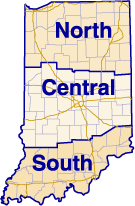If the Future is Here, Where is Indiana? Part II: Indiana Businesses
As the leading manufacturing state in the United States, Indiana has a rich legacy of Old Economy companies. These Old Economy businesses are adapting to New Economy technologies at varying rates. This article reviews key findings from interviews that assessed the patterns of computer and Internet technology adoption in Indiana.
Performed as part of Indiana Interconnect, the surveys focused particular attention (through survey over-sampling) on four different industry sectors: agriculture, distribution/logistics, life sciences and manufacturing. The latter three have been identified as key technology clusters for Indiana. Information technology, the fourth key technology cluster, was not over-sampled because it is assumed that companies self-identified as “IT” are, by their nature, technology adopters.
Overall, the geographic location of companies did not have a significant influence on the technology adoption profile of companies surveyed. (In contrast, a companion survey of individuals in Indiana households showed a strong regional component to computer and Internet use patterns, as addressed in the May-June 2003 issue of IN Context). However, company size and industry sector were significant determinants of technology penetration, levels of sophistication, performance expectations and dependence. Results from the study also validated the 2002 report by the Progressive Policy Institute (PPI) that ranked Indiana fourth in the U.S. for online manufacturing but 38th for online agriculture. The PPI study did not rank the other industry sectors.
Do You Have Access to a Computer?
When compared to responses obtained by the Technology Policy Group in a study of the U.S. and Ohio, business use of computers was more widespread in Indiana than in the U.S. or in Ohio in 2002 (see Figure 1), with the exception of agricultural enterprises. Only 46 percent of agricultural companies interviewed used computers. By contrast, computer use among other sectors was widespread, with penetration between 80 percent and 88 percent.
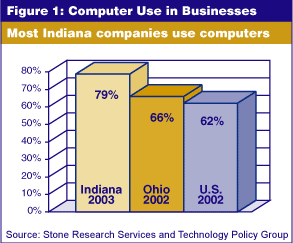
Company size is a good predictor of technology adoption, with three-fourths of small companies (25 employees or less) using computers compared to at least 94 percent for larger companies. However, not all employees use a computer at work. Of businesses using computers, the majority of employees use computers at work in 35 percent of the agricultural companies, 39 percent of distribution/logistics companies, 39 percent of manufacturing companies and 59 percent of life sciences companies.
According to responses from companies that use Internet and computer technology, most employees depend on peer training on the job to learn technology skills, as indicated in Figure 2. This underscores the importance of recent work-skill gap analyses and state grants that support technology training.
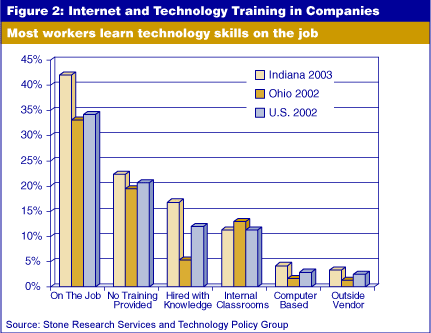
What Information and Internet Technology Do You Use?
Manufacturing companies were the heaviest users of e-mail for both internal and external communications (84 percent), exceeding the 73 percent use displayed by “other sectors.” Figure 3 displays the types of technology use by businesses according to industry sector.
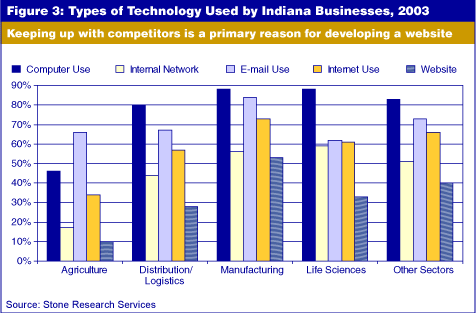
Indiana manufacturing companies were much more likely to use company websites than those in other sectors: 53 percent compared to only 33 percent for life sciences companies and 10 percent for agricultural enterprises. This illustrates how industry sector plays a key role in determining the pattern of technology used. According to the Indiana companies interviewed that have their own websites, 83 percent said their competitors also have websites.
In addition to keeping up with competitors, the primary reasons cited for developing a website by at least two-thirds of respondents were customer service and business expansion. A more granular analysis of the survey data revealed that 73 percent of manufacturing companies use their websites to provide product specifications and information. This differs markedly from other sectors and indicates a heavier dependence on the company website as a critical business operation. It also reflects the trend among manufacturing companies to publish catalogs and manuals online. Automotive mechanics, for example, go to manufacturer websites for assistance with diagnostics, part identification and ordering. This paperless approach also drives demand for broadband access in order to use the mechanic’s time efficiently.
Companies in the distribution/ logistics sector tend to use technology effectively for sales and marketing. Based on their extensive use of company websites, 20 percent of manufacturing and distribution/ logistics companies anticipate increased future revenue due to Internet use. Among survey respondents from manufacturing companies, 28 percent attribute increased overall revenue to Internet use, slightly higher than average for Indiana companies (20 percent).
Overall, Indiana companies recognize only a small percentage of their revenue from the Internet. Respondents from manufacturing companies quoted the highest Internet revenue: 39 percent attributed up to 25 percent of revenue to the Internet. On the other hand, increased productivity was observed, particularly in distribution/logistics, manufacturing and “other sectors” (see Figure 4). Enhanced communications, expanded access to information and more efficient business operations were the areas cited for increased productivity.
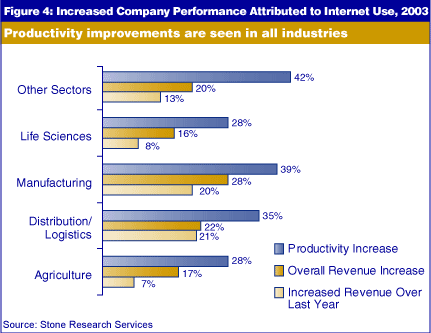
How Do You Access the Internet?
The preferred method of Internet access is largely a function of company size and sector. Agricultural companies are by far the most likely to use dial-up connections at 82 percent (see Table 1).
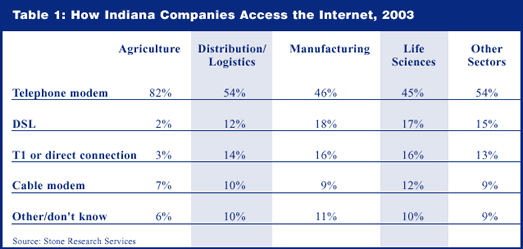
Larger non-agricultural operations strongly favor dedicated circuits (ISDN or T1). Telephone modems account for more than half of business Internet connections, averaging 53 percent for the state. A geographic look shows that broadband connections (over DSL, T1 lines or cable modems) are more widespread in the central region (38 percent) than in the North (31 percent) or South (30 percent). Higher speed access is also demanded by companies with websites; only 39 percent of those with websites access the Internet via dial-up connections, as compared to 69 percent for other companies.
Conclusions
Computer and Internet technology is significantly more prevalent among non-agricultural companies that employ more than 25 people. And while the majority of Indiana businesses own computers, the majority of employees do not have access to them and will not receive training from their company to use them. On the other hand, manufacturing companies, especially larger ones, are aggressively adopting Internet technology. Along with the distribution/logistics sector, manufacturing leads the state in website use. More sophisticated use of the Internet has resulted in increased revenue, improved productivity and a greater demand for broadband performance.
But smaller firms have not benefited from technology adoption to the same extent, even though their payoff is likely to be significant.
In the late 1990s, websites were widely touted for their potential to level the playing field, giving a small company the same global access as a large one. For Indiana, however, survey results indicate a growing division between small businesses and larger ones. The New Economy is advertised as benefiting the agile. Indiana’s small businesses must discover that agility.
Jennifer Kurtz
eCommerce Director, Indiana Department of Commerce

